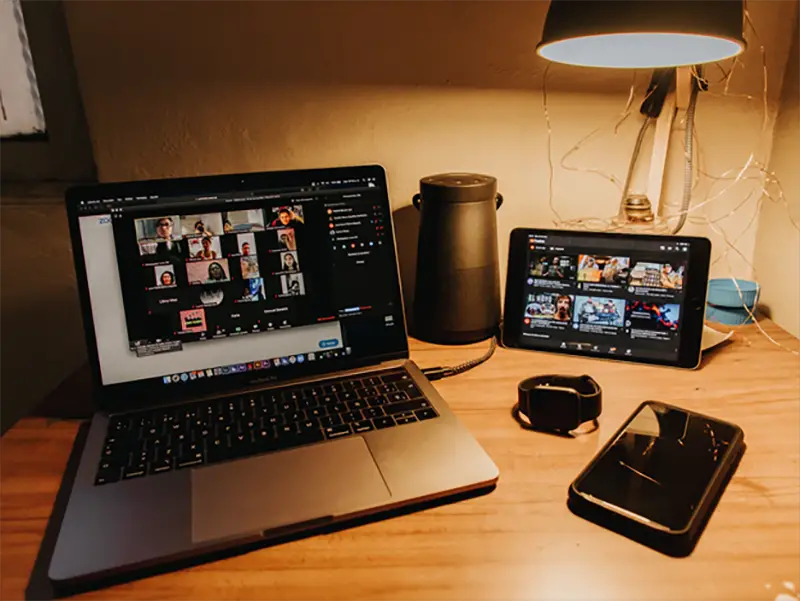Click here to get this post in PDF
What Does it Mean to Stream?
Unless you live under a rock, the term or phrase rather “to stream” is quite a quite common statement when referring to watching a show or movie online. Before Hulu, Prime, HayU, and even Netflix, streaming meant going to a rental store such as Blockbuster and borrowing the film to then return it.
Thanks to the advancement of technology, streaming has gone digital, with various companies and stations coming out with their type of streaming service. Though there are great conveniences thanks to a video streaming platform, a few things to note can sometimes impact one’s viewing experience.
Pros and Cons of Streaming
There are many noteworthy pros and cons with a video streaming platform, especially if you are considering using such a service or are thinking of creating your own IPTV platform.
Pros
- No commercials – It can sometimes feel that in a 30-minute show, more time is spent watching commercials than the actual program itself. Despite feeling this, typically, an average show has anywhere between eight to 10 minutes of commercial allocation. Naturally, many streaming services can provide shows with no commercials; however, there may be some instances where there is the occasional advert here and there.
- Capitalize on live events – Many sporting events can now let viewers and fans participate in the excitement of a major match.
- Customized viewing needs and wants – Create a platform that meets the needs of your target market.
- Convenience – Technological advancements have made life much easier. With a streaming platform, viewers can watch anytime and anywhere, as long as they have an internet connection.
Cons
- Costly to operate – Whether you are the one who owns the streaming service or are the consumer, there are hefty costs associated with an IPTV/OTT platform that either the company is going to pay or the consumers. This can be a deterrent for anyone looking to cut the cord and try a streaming service.
- Limited selection – Depending on your streaming services and providers, consumers may find themselves having to wait a bit longer for a new release to go onto the site. Take, for example, Disney; they have taken their services one step further and now provide the ability for their consumers to watch new releases from the comforts of their home. However, there is a price to access this premium service paid on top of the monthly subscription.
These are just a few of the pros and cons that come with having a streaming service, subscribing, or even creating a streaming service.
IPTV and OTT – What Are They?
The terms IPTV and OTT may be used for a video streaming platform and creating one’s service. However, before venturing into the world of video streaming, it is essential to understand the difference between the two and how it could impact what kind of service you want to provide or offer.
IPTV, also known as Internet Protocol Television, is when you use the internet to deliver content. Prime examples of IPTV include local network stations that provide streaming services such as HBO, TLC, and A&E.
OTT, or Over-the-Top-Content, is similar to IPTV. You stream it via an internet connection; however, the most significant difference is that OTT’s connection is not private, whereas IPTV is a secure connection. Examples of OTT include Netflix, YouTube, Disney, and Hulu.
Which is better?
When it comes to IPTV and OTT, each style has its ups and downs. With OTT video streaming platforms, some providers offer free content (YouTube, Tubi, Hulu); however, they also provide monthly tiered subscriptions that allow for specific accesses. Using OTT is also easy, as you can use any personal streaming device; with IPTV, you require an additional piece of equipment. If a company or business is looking at IPTV or OTT options, Setplex is one company that works with them to determine the best solution and options.
OTT providers show both internal and external shows; for example, Netflix now produces and creates its own shows and movies, making it only accessible via the platform.
It can be hard to determine which is a better option as both have pros and cons; however, what can dictate a decision is understanding what is essential to the company and viewer.
With OTT, everything is dependent on an internet connection, for, without this, no streaming can happen. With IPTV, as it uses an external product, it may not rely solely on the internet for streaming.
Local vs. Global Streaming
After understanding the different types of streaming, such as an IPTV platform versus an OTT streaming, it helps to take this understanding a step further with knowing the difference between local and global streaming platforms.
Local platforms include everything from NimiTV, TValb, Vivoplay, and Kinopoisk. These platforms cater to viewers who are looking for unique, and often language and region-specific content.
Another distinguishing feature of local IPTV platform providers is that the IPTV companies provide content that is region specific, for example, Nimi TV is a platform that provides European content for those living abroad. The application is available for streaming on iOS, as well as Android. There is also the option to listen to European radio stations.
Global streaming platforms are the Hulu’s, Netflix, Amazon Prime, and Disney of video streaming platforms. They are accessible around the world, sometimes their content varying from region to region; however, quite similar across the board. They offer the functionality of downloading content for a period of time that can be viewed offline.
Is it hard to launch a video streaming platform?
Not at all! In as little as 24-hours, you could have a fully functional and ready-to-market streaming platform with our services.
How easy is it? All it takes is doing the seven steps.
- Import your selected channels. Determine if you are going to have a wide array of content or genres or if your content is going to be niche-specific.
- Transcode your content for HD or SD streaming. HD quality streaming takes up more bandwidth and space, while SD does not. This can be important to consider if you are going to make your content downloadable to the device for offline streaming.
- Select where you plan to allow for streaming.
- Taking the live transcoding API and parameters for streaming, you can now integrate into middleware or mainframe. This is where creating the interface and menu creation takes place – you want to make sure your streaming platform is easy to use and navigate.
- Create and configure security settings. This is important as many times, companies who have security breaches find themselves losing trust in a provider that is not secure.
- Application customization is where you begin to integrate your logo and brand. Do you have a slogan or a distinguishable icon? Netflix, Hulu, and Youtube have easily recognizable icons. If you want to have success with your video streaming platform, create an icon that is also iconic.
- Launch time, despite feeling as though this was a lengthy process, the platform’s launch is on you – the company or business. Consider how you plan to entice people to try out your services or choose you over other competitors. Sometimes companies offer a special trial period for potential customers to try out the platform and view the content.
Create a Lasting Brand and Service
If you have an idea that requires technical support and complex coding to come to fruition, consider reaching out to the staff at Setplex as your one-stop shop for IPTV and OTT creation. The market when it comes to being an IPTV platform provider is vast, there are ample opportunities when it comes to creating a niche and style that is to attract viewers. If you choose to go with a local platform, that is region, language, and content specific, you can find stability and success with your platform.
Bring content from around the world to those who are looking to stay connected to their home, wherever that may be!
Things to Consider When Choosing a Live Streaming Platform
Empowering Content Creators with Fairer Streaming Deals and Bigger Profits
About the Author
Stacy Chabot is a digital marketing specialist at Setplex – OTT/IPTV solutions provider that helps content owners to build or upgrade to a state-of-the-art OTT/IPTV solution that is future-proof, and delivers a superior user experience across all major platforms.
Here at Setplex Stacy works on the company’s brand awareness on the Internet. She has a strong marketing and sales background with over 6 years in the B2B market. She obtained the Google Analytics Certificates and updates them yearly.
When not working Stacy enjoys trying new sports, going on hikes, and miss traveling the world.
Image source: Unsplash.com


